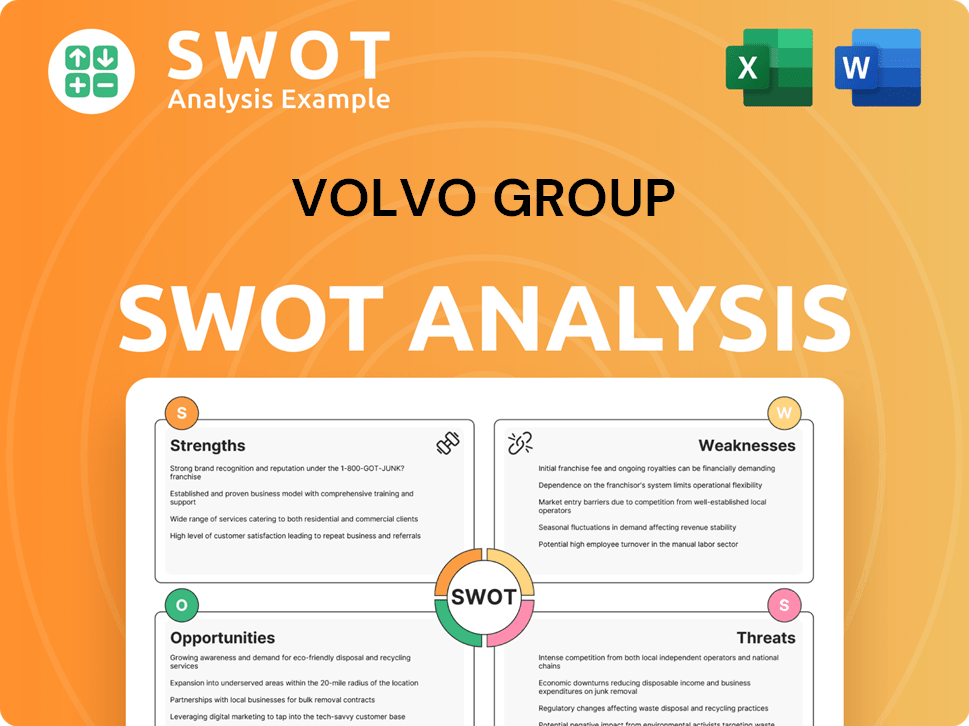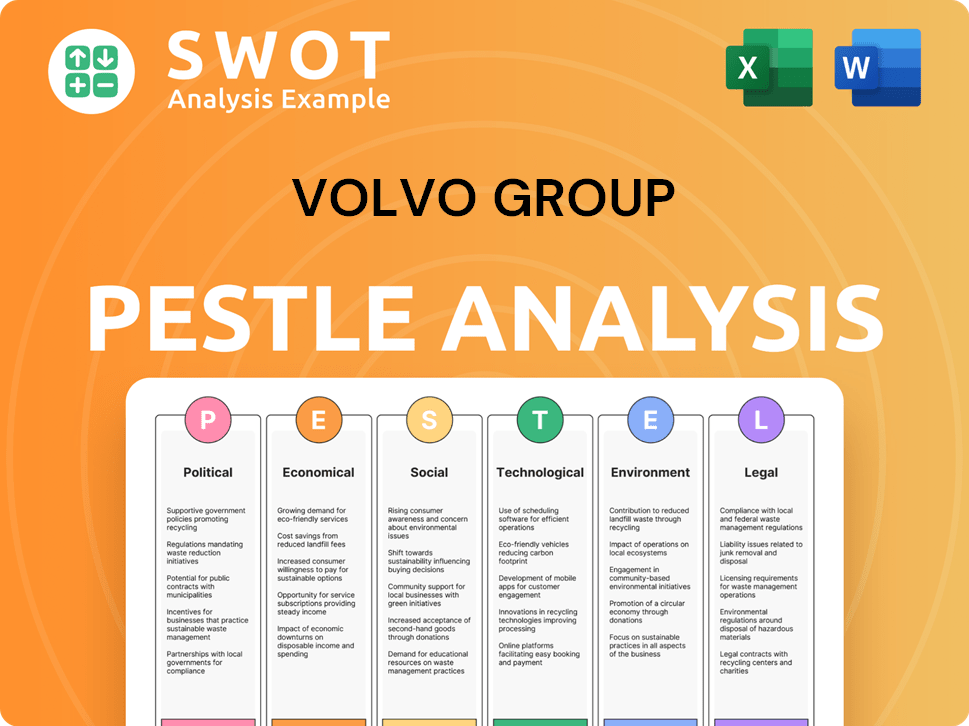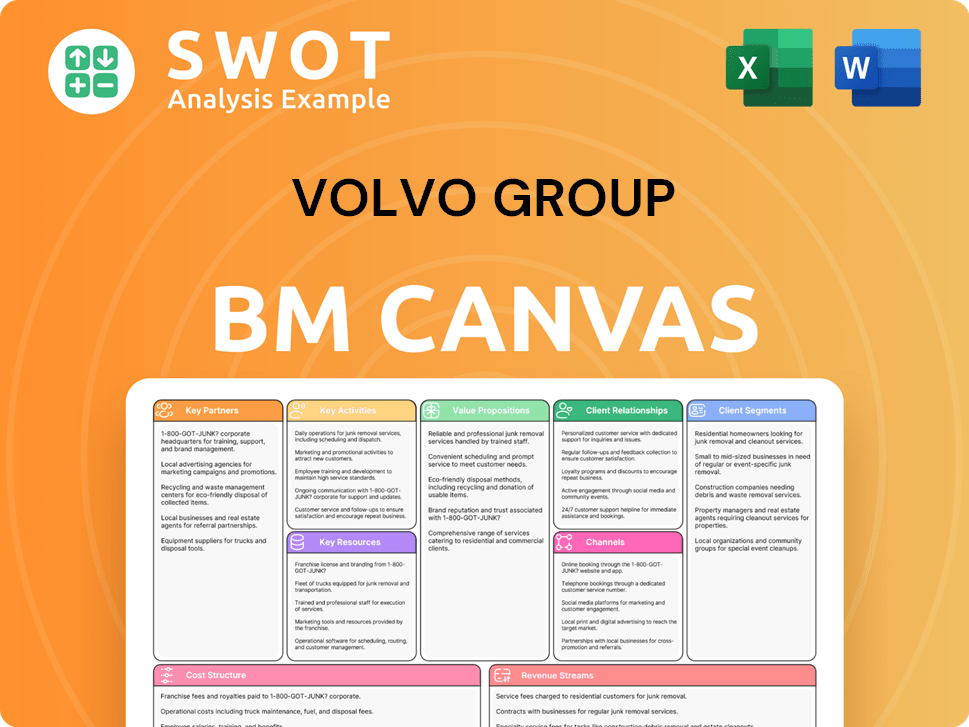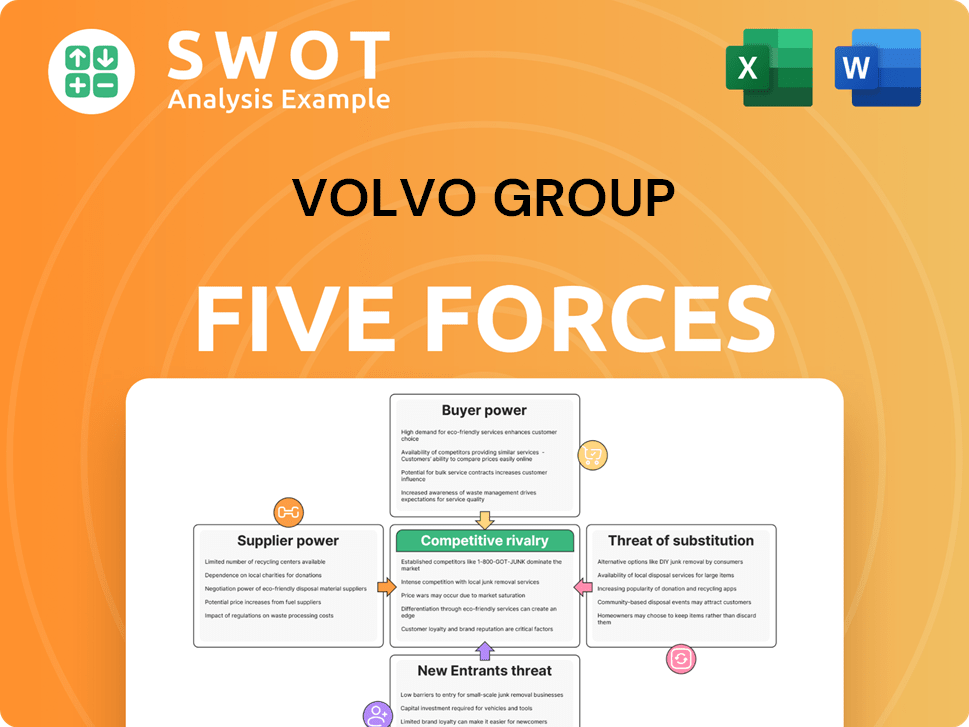Volvo Group Bundle
How Does Volvo Group Navigate the Global Transport Arena?
In the dynamic world of commercial vehicles and infrastructure, the Volvo Group has carved a significant niche. Founded in 1927, the company has evolved from its automotive roots to become a global leader in trucks, buses, construction equipment, and engines. But how does Volvo Group maintain its competitive edge in a market teeming with rivals and constant innovation?

This analysis provides a comprehensive look at the Volvo Group SWOT Analysis, its competitive landscape, and the strategies that drive its performance. We will delve into the Volvo Group's market analysis, dissecting its key competitors and examining its strengths, weaknesses, opportunities, and threats. Understanding the Volvo Group industry dynamics is crucial to grasping its strategic positioning and future growth potential.
Where Does Volvo Group’ Stand in the Current Market?
The Volvo Group maintains a strong position in the global commercial transport and infrastructure sectors. The company's diverse portfolio includes trucks, buses, construction equipment, and marine and industrial engines. In Q1 2024, the company demonstrated robust financial performance, with net sales reaching SEK 148.1 billion, reflecting an 8% increase compared to the same period in the previous year.
Volvo Trucks, a core segment, is a significant contributor to the group's profitability. The company's global presence spans across Europe, North America, South America, and Asia, with a substantial market share in key regions. The company's strategic focus on innovation, particularly in electric vehicles, is aimed at solidifying its market position and addressing future industry trends.
The Volvo Group's competitive landscape is shaped by its broad product offerings and global reach. The company's financial performance, including an adjusted operating income of SEK 18.2 billion in Q1 2024, underscores its strong position. The company's ability to adapt to market changes and invest in new technologies, such as battery electric vehicles (BEVs) and fuel cell electric vehicles (FCEVs), is crucial for its long-term success.
Volvo Trucks holds a leading position in the European heavy-duty truck market and has a strong presence globally. In Q1 2024, global truck deliveries reached 60,400 vehicles. Deliveries in North America increased by 11% in Q1 2024 compared to Q1 2023, indicating strong market performance in the region.
The company's financial results reflect its strong market position. The adjusted operating margin for Volvo Trucks was 14.8% in Q1 2024. The company's investments in new technologies, including electric vehicles, are expected to drive future growth and maintain its competitive edge. The Target Market of Volvo Group is a key factor in its success.
Volvo Group has a significant global footprint with a strong presence in Europe, North America, South America, and Asia. North America is a particularly strong market, with increasing truck deliveries. The company's diverse geographic presence helps mitigate risks and supports sustainable growth.
The product portfolio includes heavy-duty trucks, buses, construction equipment, and marine and industrial engines. Volvo Construction Equipment, despite a decrease in net sales in Q1 2024, remains a key player in the construction machinery market. This diversified portfolio supports the company's market position.
The Volvo Group's competitive landscape is defined by its financial performance, market share, and strategic investments. The company's focus on sustainable transportation and its global presence are key factors in its market position. The company is actively involved in the Volvo Group competitive landscape.
- Increased net sales of 8% in Q1 2024.
- Adjusted operating income of SEK 18.2 billion in Q1 2024.
- Strong performance in North America with an 11% increase in truck deliveries.
- Investments in electric vehicles to secure future market position.
Volvo Group SWOT Analysis
- Complete SWOT Breakdown
- Fully Customizable
- Editable in Excel & Word
- Professional Formatting
- Investor-Ready Format

Who Are the Main Competitors Challenging Volvo Group?
The Marketing Strategy of Volvo Group faces a dynamic competitive landscape. Understanding the key players and their strategies is crucial for assessing its market position and future prospects. This analysis delves into the major competitors across different segments, offering insights into their strengths, weaknesses, and strategic initiatives.
The Volvo Group competitive landscape is shaped by a diverse range of global and regional players. These competitors challenge the company across various aspects, including technological advancements, fuel efficiency, and global distribution networks. This competitive pressure necessitates continuous innovation and strategic adaptation to maintain and enhance market share.
Volvo Group's market analysis reveals a complex interplay of competitors. Each segment, from heavy-duty trucks to construction equipment, has its own set of key rivals. The company's performance is directly influenced by its ability to effectively compete against these established and emerging players.
In the heavy-duty truck segment, Volvo Group's main rivals in the heavy-duty truck market include Daimler Truck, which manufactures Freightliner and Mercedes-Benz trucks. These competitors challenge Volvo in fuel efficiency and technological advancements.
Traton Group, the parent company of Scania and MAN, is another significant competitor. These rivals focus on global distribution networks and technological innovation. The competitive landscape is intense, with each company vying for market share.
Daimler Truck has been aggressive in developing electric trucks, aiming to gain an edge in the burgeoning electric vehicle market. This focus on electric vehicles highlights a key area of competition and innovation within the industry. The competition is fierce.
In the bus sector, competitors like Daimler Buses (Mercedes-Benz and Setra) and BYD, particularly in the electric bus segment, vie for market share. The bus segment is a key area of competition for Volvo.
Key competitors in construction equipment include Caterpillar, Komatsu, and John Deere. These companies compete on product innovation, after-sales service, and global reach. The construction equipment market is highly competitive.
Volvo Penta, the marine and industrial engine division, competes with companies such as Cummins, Yanmar, and Mercury Marine. Focus is on performance, reliability, and emissions compliance. This is a key area of competition.
Emerging players, particularly from China, are also increasing their presence in various segments, offering competitive pricing and rapidly advancing technology. Strategic alliances and mergers in the automotive and heavy vehicle industries can alter market dynamics and competitive pressures. Volvo Group's competitive advantages and disadvantages are constantly being evaluated.
- Volvo Group's industry is influenced by consolidation.
- Volvo Group's strategy includes responding to industry trends.
- Volvo Group's performance is tied to its ability to innovate.
- Volvo Group's challenges in the current market are significant.
Volvo Group PESTLE Analysis
- Covers All 6 PESTLE Categories
- No Research Needed – Save Hours of Work
- Built by Experts, Trusted by Consultants
- Instant Download, Ready to Use
- 100% Editable, Fully Customizable

What Gives Volvo Group a Competitive Edge Over Its Rivals?
Understanding the Volvo Group competitive landscape involves recognizing its multifaceted advantages. These stem from a long-standing focus on innovation, safety, and sustainability. The company's strong brand equity, recognized globally for quality and durability, is a cornerstone of its success. This reputation fosters significant customer loyalty, especially in the premium segments of the truck and bus markets. A deep dive into the Volvo Group market analysis reveals the strategies that have solidified its position.
Volvo Group's proprietary technologies, particularly in powertrain development and telematics, provide a distinct edge. For instance, its I-Shift automated manual transmission is a significant differentiator, improving fuel efficiency and driver comfort. The company is also a leader in developing electric and autonomous vehicle technologies for commercial applications, investing heavily in R&D to maintain its technological lead. Examining the Volvo Group industry reveals its commitment to adapting to changing market demands.
Economies of scale, derived from its global manufacturing footprint and extensive distribution network, allow Volvo to optimize production costs and reach diverse markets efficiently. Its comprehensive service and financing solutions create a strong value proposition, enhancing customer retention and recurring revenue streams. The company's focus on safety, embedded in its product design and engineering, remains a powerful differentiator, appealing to customers prioritizing operational safety and driver well-being. To learn more about the company's strategic growth, you can read about the Growth Strategy of Volvo Group.
The Volvo Group's brand is synonymous with quality, durability, and advanced engineering. This reputation fosters strong customer loyalty, particularly in premium segments. The company benefits from repeat business and a loyal customer base, which is critical in the competitive truck and bus markets.
Volvo invests heavily in R&D, particularly in powertrain development and telematics. Its I-Shift automated manual transmission is a key differentiator. The company is also a leader in electric and autonomous vehicle technology, ensuring its competitive edge.
Volvo leverages its global manufacturing and distribution network to optimize costs and reach diverse markets. This extensive network allows for efficient production and distribution. The company's economies of scale contribute to its competitive advantage.
Volvo's commitment to sustainability, including electric vehicles and circular economy initiatives, aligns with evolving regulatory landscapes and customer preferences. This proactive approach positions the company favorably for future growth. The company is investing heavily in sustainable transportation solutions.
Volvo Group's competitive advantages are centered around brand strength, technological innovation, and operational efficiency. These factors contribute to its strong market position. Volvo Group's strategies are designed to maintain its leadership in the industry.
- Strong Brand Equity: Globally recognized for quality and reliability.
- Technological Leadership: Investments in electric and autonomous vehicles.
- Global Presence: Extensive manufacturing and distribution network.
- Sustainability Focus: Commitment to electric vehicles and circular economy.
Volvo Group Business Model Canvas
- Complete 9-Block Business Model Canvas
- Effortlessly Communicate Your Business Strategy
- Investor-Ready BMC Format
- 100% Editable and Customizable
- Clear and Structured Layout

What Industry Trends Are Reshaping Volvo Group’s Competitive Landscape?
The commercial transport and infrastructure sectors are undergoing significant transformation. This evolution presents both challenges and opportunities for the Volvo Group competitive landscape. Technological advancements, regulatory changes, and economic shifts are key drivers. Understanding these dynamics is crucial for evaluating the Volvo Group's strategy and future prospects.
The Volvo Group industry faces risks from supply chain disruptions, economic pressures, and geopolitical uncertainties. However, emerging markets and technological innovations offer growth potential. The company's ability to adapt and innovate will determine its success in the evolving market. For a deeper dive, consider reading about the Brief History of Volvo Group.
Electrification, automation, and connectivity are reshaping the commercial transport sector. Environmental regulations and demand for sustainable solutions are driving the shift to electric vehicles (EVs). The company is investing heavily in battery electric and fuel cell technologies. The company aims for 35% of its total truck sales to be electric by 2030.
Managing the transition from combustion engines to EVs is a significant challenge. Building out charging infrastructure and navigating stricter emissions standards are crucial. Economic shifts, supply chain issues, and geopolitical uncertainties also pose risks. These factors can impact production, profitability, and global demand.
Emerging markets offer substantial growth potential due to ongoing infrastructure development. The increasing demand for efficient and sustainable logistics drives innovation in connectivity and digital services. Autonomous driving technologies could unlock new business models and operational efficiencies for fleet operators. These areas are key for Volvo Group's performance.
The company's strategy includes continued investment in research and development. Strategic partnerships and a focus on customer-centric solutions are also priorities. The company aims to remain a leader in the evolving transport ecosystem. This approach is designed to navigate challenges and capitalize on future opportunities.
The Volvo Group's competitive landscape is influenced by its ability to innovate and adapt. The company is focusing on several key areas to ensure future success. These include strategic investments, partnerships, and customer-centric solutions.
- Electrification: Expanding its electric vehicle offerings for trucks and buses.
- Automation: Developing and deploying autonomous driving technologies.
- Connectivity: Enhancing digital services for fleet management and logistics.
- Sustainability: Reducing emissions and promoting sustainable transport solutions.
Volvo Group Porter's Five Forces Analysis
- Covers All 5 Competitive Forces in Detail
- Structured for Consultants, Students, and Founders
- 100% Editable in Microsoft Word & Excel
- Instant Digital Download – Use Immediately
- Compatible with Mac & PC – Fully Unlocked

Related Blogs
- What are Mission Vision & Core Values of Volvo Group Company?
- What is Growth Strategy and Future Prospects of Volvo Group Company?
- How Does Volvo Group Company Work?
- What is Sales and Marketing Strategy of Volvo Group Company?
- What is Brief History of Volvo Group Company?
- Who Owns Volvo Group Company?
- What is Customer Demographics and Target Market of Volvo Group Company?
Disclaimer
All information, articles, and product details provided on this website are for general informational and educational purposes only. We do not claim any ownership over, nor do we intend to infringe upon, any trademarks, copyrights, logos, brand names, or other intellectual property mentioned or depicted on this site. Such intellectual property remains the property of its respective owners, and any references here are made solely for identification or informational purposes, without implying any affiliation, endorsement, or partnership.
We make no representations or warranties, express or implied, regarding the accuracy, completeness, or suitability of any content or products presented. Nothing on this website should be construed as legal, tax, investment, financial, medical, or other professional advice. In addition, no part of this site—including articles or product references—constitutes a solicitation, recommendation, endorsement, advertisement, or offer to buy or sell any securities, franchises, or other financial instruments, particularly in jurisdictions where such activity would be unlawful.
All content is of a general nature and may not address the specific circumstances of any individual or entity. It is not a substitute for professional advice or services. Any actions you take based on the information provided here are strictly at your own risk. You accept full responsibility for any decisions or outcomes arising from your use of this website and agree to release us from any liability in connection with your use of, or reliance upon, the content or products found herein.